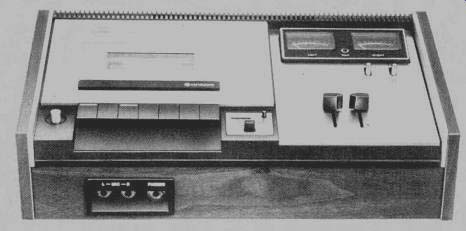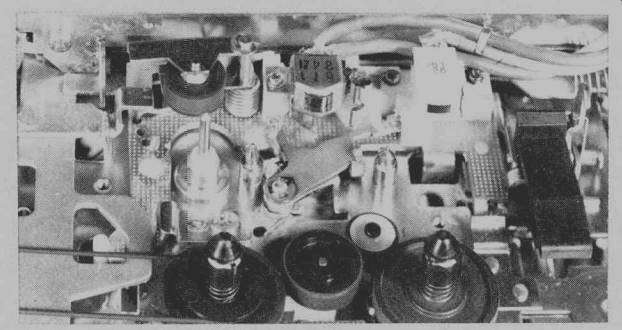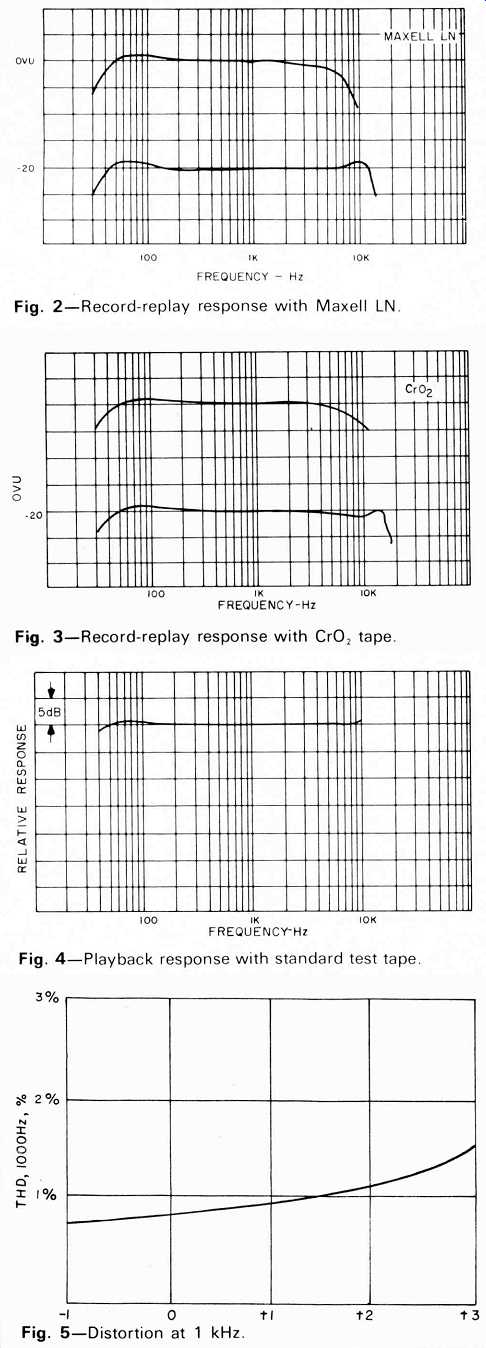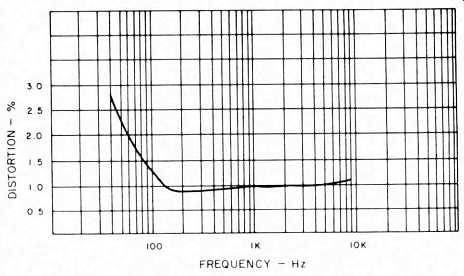
MANUFACTURER'S SPECIFICATIONS
Frequency Response: 40 to 12,000 Hz with regular tape; 40 to 16,000 Hz with CrO2. Wow and Flutter: 0.25%.
Signal to Noise: Better than 53 dB. Output Level: 0.775 volts, variable.
Output Impedance: 100 ohms.
Headphone: 8 ohms. Dimensions: 16 in. W by 10 1/4 in D by 3 7/8 in. H.
Weight: 10.3 lbs.
Price: $199.95.
Hitachi is one of the largest Japanese electronic companies and they make all kinds of things from cathode ray tubes to ICs and high power radio stations to tape recorders and other high fidelity products-not forgetting Maxell tape! The cassette recorder reviewed here is a typical Dolbyized unit with provision for CrO2 tapes, slide controls, memory rewind and so on. It uses 11 transistors and eight ICs-- Hitachi, of course. Looking at the top panel, the seven piano keys on the left are for EJECT, REWIND, FAST FORWARD, RECORD, PLAY BACK, STOP, and PAUSE. The fast forward and rewind keys are latched so they lock into place if pressed to the limit. Next to these controls are the digital counter and memory switch and to the right are the two slide controls for record levels. At the lop right are the VU meters, mounted on an inclined panel, and just in front is the Dolby switch and tape selector which is labeled CrO2 and NORMAL. The power on-off switch, a push button type, is on the extreme left and the microphone and headphone sockets are located in a recess at the front. Input and output sockets are at the rear with a pre-set ganged level control. A DIN socket is also to be found at the rear. One novel feature which could well be copied by other manufacturers is the removable head cover. It cannot be emphasized too strongly that heads in cassette recorders must be kept absolutely clean for best performance.

Fig. 1--head assembly.
The motor is a 4-pole hysteresis synchronous type fitted with a heavy flywheel and the transport mechanism is automatically returned to the stop position at the end of a cassette. The tape head is made of ferrite.
Measurements

Fig. 2-Record-replay response with Maxell LN.
Fig. 3-Record-replay response with CrO2 tape.
Fig. 4-Playback response with standard test tape.
Fig. 5-Distortion at 1 kHz.

Fig. 6--Distortion versus frequency.
Figure 2 shows the record-replay response with Maxell LN tape. The 3 dB point is at 12.7 kHz. Maxell UD gave a some what wider response extending the 3 dB point to nearly 14 kHz at the expense of a rise of 2.5 dB at 10 kHz, 3 dB at 12 kHz falling to 0 dB at 13 kHz. Flattest response of all tapes tested on this machine (on the NORMAL tape setting) was Capitol 2 which was within 0.5 dB from 1 kHz to 11 kHz with a 3 dB point at 12.5 kHz. Several CrO2 tapes were tested, including Advent, Norelco and TDK KROM--all of which came out pretty much the same as shown in Fig. 3. It will be seen that there is a bigger margin between CrO2 tapes and low-noise tapes on this machine than with some other recorders probably because of the parameters adopted for normal tapes.
Figure 4 shows the playback response from a standard test tape and the distortion characteristics can be seen from Figs. 5 and 6. Distortion at 0 VU, I kHz was less than 1 percent, increasing below 100 Hz although it fell sharply at-3 VU. Signal-to-noise came out at 51 dB ref. 0 VU increasing to 57 dB with Dolby switched in. If the figures are related to 3 percent, they would be 55 dB and 61 dB respectively. The Dolby characteristics were checked and showed no significant variation in frequency response-less than 1 dB in fact. Input voltage for 0 VU was 64 millivolts line and 0.22 millivolts for microphone. Output voltage under these conditions checked out at 0.78 volts. Wow and flutter was 0.21 percent (record-replay) which is excellent for a recorder not using an elaborate servo-controlled system, but the type of motor used is notable for good regulation. Tape rewind time clocked in at 67 seconds for C-60 and tape speed was less than 1 percent slow.
Listening Tests
The TRQ-2040 proved to be a very easy recorder to use. The piano keys all worked smoothly without undue pressure and were nice and positive. The pause control functioned with just a slight touch and it would lock into position by pressing a little harder--a nice touch (if I can be forgiven for the obvious pun). It was possible to use the playback and rewind keys for inching, that is moving the tape a short distance back and forth to find a particular spot. And then there is the memory rewind feature that permits the tape to be returned to a pre determined position--a gadget that I find handy at times.
Several tapes were made, mostly from records transferred via a Shure V-15/III and a Thorens 125, and, as might be expected, the CrO2 tapes were superior. No, there was not a great difference, especially when the Dolby system was switched in, but it could be heard.
Summing up, the 2040 impressed me as being a well-made machine with a good all around performance and above average reliability.
--G. W. T.
(Adapted from: Audio magazine, Jun. 1974)
Also see:
Hitachi PCM-V300 Digital Audio Recorder (Equip. Profile, Jun. 1982)
= = = =